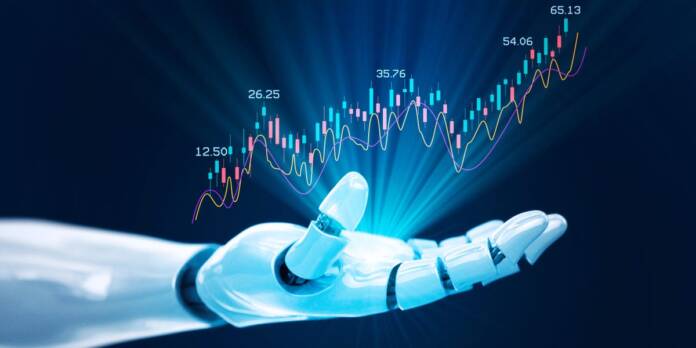- AI is all the rage in the stock market right now.
- AI-affiliated mega-cap stocks like Nvidia have been backstopping a market facing a series of headwinds.
- It’s a push-and-pull relationship that could define stocks over the next decade.
The surge in interest around artificial intelligence triggered by the sudden popularity of ChatGPT has created trillions of dollars of stock market value.
Nvidia is the leader in the clubhouse so far this year, having spiked more than 175% to join the $1 trillion club, while Meta is also up 119%. Juggernauts like Alphabet and Microsoft have seen returns approach 40%. This is all happening as the US economy lumbers towards a recession and Congress plays a game of chicken with the nation’s debt limit.
It’s exactly what the stock market has needed to stay afloat as headwinds — including an earnings slowdown and elevated interest rates — have continued to pile up. The S&P 500 is basically flat since the beginning of April, with the AI hype helping to offset multiple economic challenges.
This push and pull is indicative of a battle that will likely play out over the next decade. As negative forces combine to drag stocks lower, it’s increasingly looking like AI can be the bright spot that offsets that.
There are two core elements in play: the productivity boost that widespread AI adoption is supposed to drive, and the resulting positive impact on profit margins, which are the primary driver of stock gains.
AI is expected to increase productivity
The case for an AI-led productivity boom isn’t just being led by stock bulls. Academic researchers have also reached the same conclusion.
A recent study from Stanford and MIT found that workers at a Fortune 500 software company who were given generative AI tools got 14% more productive. Those gains approached 30% for the least experienced workers.
“The system appears to create value by capturing and conveying some of the tacit organizational knowledge about how to solve problems and please customers that previously was learned only via on-the-job experience,” reads a Brookings Institute summary of the report.
Some of the world’s most renowned investors and market pundits are also on board. Billionaire investor Paul Tudor Jones says the stunning mainstream popularity of AI has made him reevaluate his forecasts for inflation and the stock market.
“The introduction of large language models [and] artificial intelligence is going to create a productivity boom that we’ve only seen a few times in the last 75 years,” Jones said in a recent CNBC interview.
Market veteran Ed Yardeni — who previously served as chief investment strategist for Oak Associates, Prudential Equity Group, and Deutsche Bank — thinks AI-driven productivity has the potential to start a new prolonged bull cycle for stocks.
“This may be the event that launches the Roaring 2020s,” he wrote in a blog post a couple weeks ago. “If so, then we can spend a lot less time obsessing about what the Fed will do next and focus on how technology is boosting productivity and the standard of living throughout the economy.”
The crucial role of margin growth
To understand how this increase in productivity will translate to stock gains, one must first look at profit margins and the role they play in share-price appreciation. In order to do that, you have to go back decades.
Over the last 30-plus years, US companies have enjoyed immense growth in profit margins. Since 1990, they’ve more than doubled.
That’s been largely responsible for a more than 1,100% increase in the S&P 500 over that period. After all, earnings growth has historically been the biggest driver of share gains, and margins are a reflecton of how efficiently companies convert sales to actual profit. And as the green line in the chart below shows, it hasn’t been limited to tech titans:
Goldman Sachs
But amid a broad economic slowdown, margins have trended downward, and look poised to continue lower. Goldman Sachs finds that margins have declined by a full percentage point in recent quarters, and expects a 36-basis-point dip for full-year 2023.
This decline is poised to hamper the S&P 500’s ability to continue generating returns in line with its historical trend. That’s because margin expansion has been the market’s ace in the hole as revenue and GDP growth have slowed. Without that support, Goldman says stocks will fall below their long term average.
Goldman Sachs
AI’s impact on margins
This is where AI comes back in and ties it all together. According to Goldman, generative AI will boost US productivity growth by roughly 1.5 percentage points per year over a 10-year period. The firm expects that, in turn, to result in a 4-percentage-point increase in S&P 500 net profit margins.
That’s basically pure rocket fuel for stock returns, and it could be what keeps the S&P 500 backstopped as other positive catalysts evaporate. This chart shows the clear relationship between improving productivity growth leading to higher margins.
Goldman Sachs
As with any fast-appreciating area of the market, AI stocks are not without their naysayers.
A recent research note from Bank of America called this cohort a “baby bubble,” noting that it started under easy-money conditions and will likely end amid tightening.
And while AI may ultimately end up being hugely powerful in the long term, the firm notes that asset prices could still deflate significantly from current levels. The rise of the internet, after all, was technically a bubble.
Semantics aside, only time will tell whether how the AI revolution will separate the winners who implement it from the losers who get disrupted by it. Regardless of how that shakes out, there’s no denying that AI has the potential to be a key driver of the overall market for years to come.














